Contents
- Early History
- Colonial History
- Early Institutions
- Dr. Fraser Boys High School
- Post-Independence Era and Contemporary Educational Infrastructure
- Primary & Secondary Education
- Institutions of Higher Learning
- College Of Agriculture, Kharpudi
- College of Engineering and Technology (MSS)
- Institute of Chemical Technology
- Prominent Figures & Organizations
- Jalna Education Society
- NGOs and Community-Based Education Efforts
- Jagdish Kude and Educational Reform in Shriram Tanda
- Graphs
- Enrollment and Dropout Rate
- A. Student Enrollment Numbers
- B. Student Enrollment (Class-Wise)
- C. Student Enrollment (Gender-Wise)
- D. Student Enrollment (By School Management Type)
- E. Drop Out Rate (By Schooling Level)
- F. Drop Out Rate (By Gender)
- Schools
- A. No. of Schools
- B. No. of Schools (Filtered by Gender Mix)
- C. No. of Schools (By School Management Type)
- Teachers
- A. No. of Teachers
- B. No. of Teachers (By School Management Type)
- C. No. of Teachers (Male vs Female)
- D. Education Level of Teachers
- Sources
JALNA
Education
Last updated on 28 July 2025. Help us improve the information on this page by clicking on suggest edits or writing to us.
The educational framework of Jalna aligns with the broader structure of the Indian education system, encompassing pre-primary, primary, secondary, and higher education. By the 19th century, the introduction of the Western education framework in the district changed its educational landscape. British administrators and missionaries became actively involved in shaping education in the region. Additionally, as part of the Hyderabad State during this period, the district’s educational development was also influenced by the Nizams.
Still, even as colonial influences grew, the early 20th century saw a wave of local initiatives; its existence indicated an increasing public awareness regarding the importance of education. Local communities took charge of education, a movement that carried into the post-independence era, shaping the district’s educational landscape in lasting ways.
Early History
Much of Jalna’s early educational history remains unknown. However, this does not imply that any system of education was completely absent in the district. It is possible that, like many places across Maharashtra, some systems of education did exist in the district in earlier times.
Some figures in Indian tradition associated with learning and teaching are sants. Many of them shaped religious and social discourse in ways that continue to resonate. One such figure tied to Jalna is Sant Samarth Ramdas. Born as Narayan on Ram Navami in 1608 in Jamb, he devoted his early life to ascetic practices at Taakli, focusing on spiritual growth through chanting and devotion to Bhagwan Ram. At the age of 24, he is said to have attained spiritual enlightenment and adopted the name Ramdas.

Ramdas is known for his contributions to religious, social, and educational thought in Maharashtra. He challenged prevailing social norms by rejecting caste hierarchies and supporting women’s participation in spiritual life. He appointed female disciples to leadership roles within his ashrams and emphasised the importance of respecting women, famously stating that "those who disregard that all are born from a woman are unworthy of being called men."
His written works played a significant role in shaping ethical and spiritual education. Dasbodh, a comprehensive text addressed to disciples, covers themes such as governance, ethics, self-discipline, and social responsibility. It remains an influential text within the spiritual and educational traditions of Maharashtra. Another key work, Manache Shlok, is a collection of verses intended to guide the mind toward introspection and moral conduct.
Ramdas is regarded by many as the raja-guru (spiritual advisor) to Chhatrapati Shivaji Maharaj, though this is disputed. Nevertheless, his teachings reflect a broader concern with societal well-being and self-governance, and his emphasis on the guru-shishya tradition and moral instruction positions him as an important figure in the intellectual and social life of early modern Maharashtra.
Colonial History
By the 19th century, the introduction of British educational policies and the efforts of Christian missionary organisations brought notable changes to the educational landscape of the Jalna region. Additionally, as mentioned earlier, the district was part of the Hyderabad State during and so its educational development was also influenced by the Nizams. While detailed records for Jalna district during this period remain limited, a few early institutions played a key role in shaping access to formal education.
Early Institutions
Dr. Fraser Boys High School
One of the earliest known educational establishments in the district was the school later known as Dr. Fraser Boys' High School, founded in 1818 by the Church of Scotland Mission. Initially, Urdu was the primary medium of instruction, consistent with the linguistic and administrative context of the Nizam’s dominion.
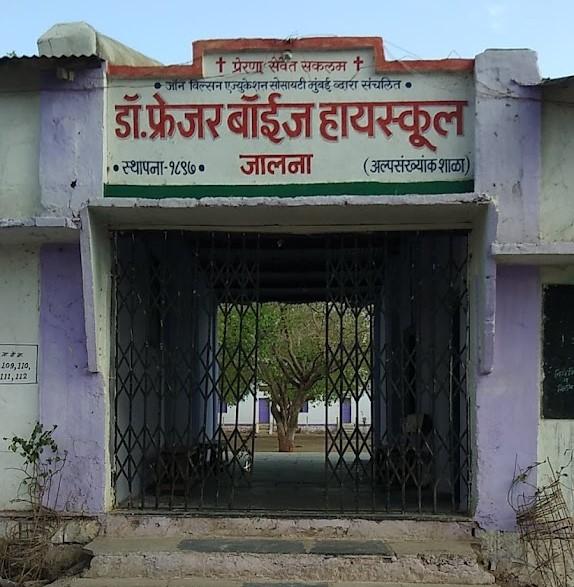
The school underwent significant development under the leadership of Dr. Duncan Fraser, who served as principal. In recognition of his contributions to its growth and reputation, the institution was renamed in his honour. It remains one of the oldest educational institutions in the region.
Post-Independence Era and Contemporary Educational Infrastructure
Following India's independence, the education system in Jalna underwent major transformations. The introduction of structured education levels, pre-primary, primary, secondary, and higher education and the implementation of National Education Policies heavily shaped the educational landscape of the district. Over the years, the education sector has developed with contributions from both government-funded institutions and private organisations. Additionally, Educational boards were also introduced, each offering distinct curricula and standards, providing students with more choices.
Primary & Secondary Education
During the colonial period, both public and private efforts in education primarily focused on primary and secondary schooling, as indicated by data from district gazetteers across Maharashtra. Higher education remained underdeveloped in most districts, including Jalna, with gradual improvements over time. While basic infrastructure for primary and secondary education existed, its expansion was closely tied to increasing enrollment and greater involvement of local figures.
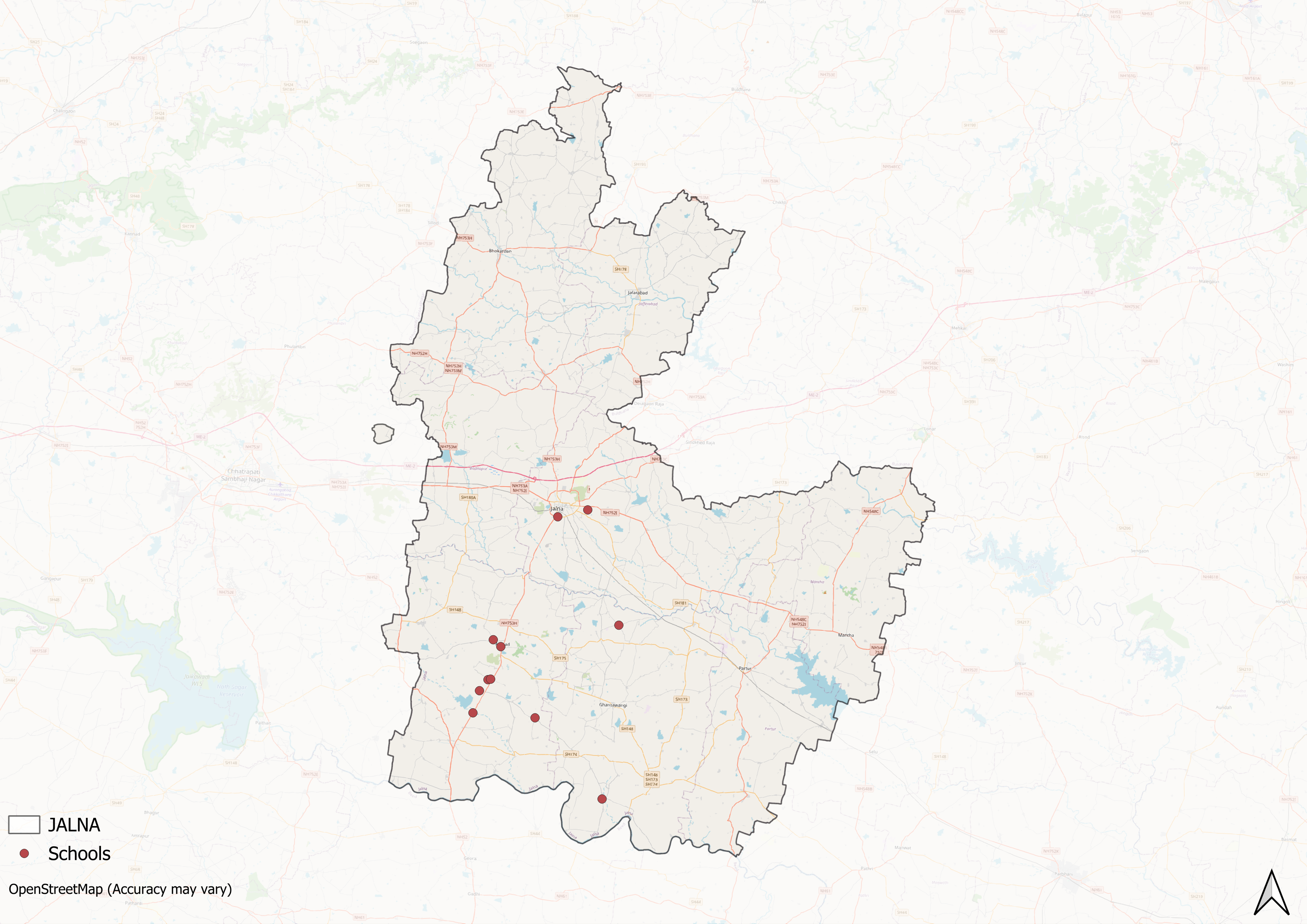
Today, this expansion is evident in the widespread presence of schools across various wards of Jalna, with available data reflecting the steady growth of educational institutions in both urban and rural parts of the district.
Over time, institutions affiliated with various educational boards also emerged. Locals identify the State Secondary Certificate (SSC) Board and the Central Board of Secondary Education (CBSE) as the two boards currently available in the district. Notably, the availability of CBSE board schools is a rather recent phenomenon.
Interestingly, in Jalna, there is a culture of nirvasit (residential) gurukuls. These institutions are typically run by non-granted or unemployed teachers who provide students with accommodation, meals, and supplementary academic support. Although these gurukuls operate independently of government regulation, they allow students to attend nearby public or private schools while residing in the facility. According to local accounts, there are hundreds of such gurukuls in Jalna city alone, with several more in surrounding talukas.
Institutions of Higher Learning
Perhaps one of the most notable changes in Jalna’s educational landscape is tied to the establishment of higher education institutions. While primary and secondary schooling expanded steadily, opportunities for advanced education remained limited for much of the district’s history. Over time, local leaders and organisations played a crucial role in addressing this gap, leading to the creation of several colleges. As a result, many institutions in the district today are privately managed, semi-private, or autonomous.
College Of Agriculture, Kharpudi
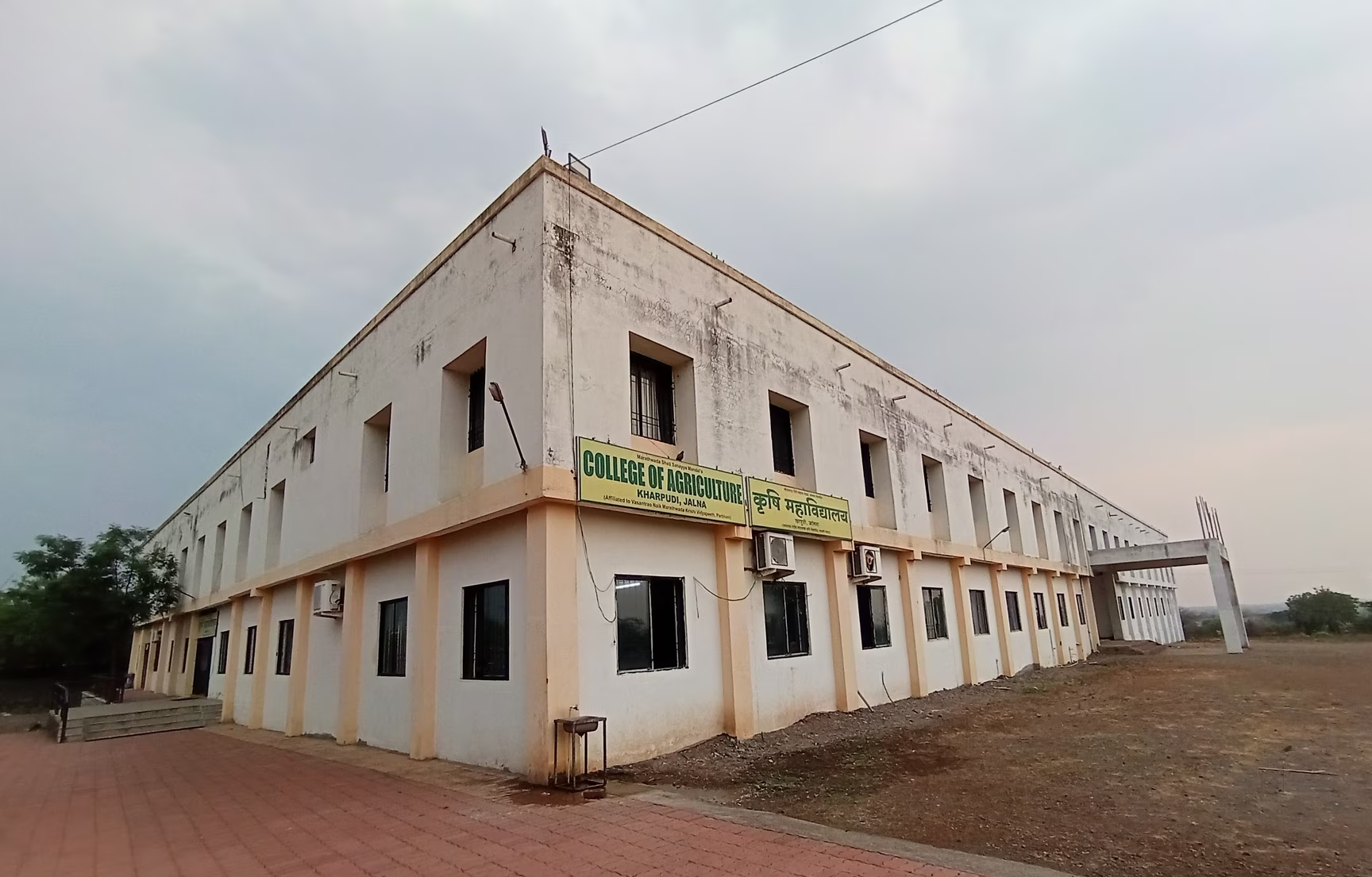
The College of Agriculture in Kharpudi was established on 10 February 1969 and functions under the Marathwada Sheti Sahayya Mandal (MSSM) trust. Given Jalna's predominantly agrarian population, the college plays an important role in promoting agricultural education. Founded with the vision of Krishiratna Vijayanna Borade, the institution focuses on disseminating contemporary agricultural practices and technologies to support rural livelihoods and local economic development.
College of Engineering and Technology (MSS)
The College of Engineering and Technology, established under the MSS trust, is regarded to be the first and only engineering college in Jalna district. It was founded with the objective of offering affordable and quality technical education, particularly for students from economically disadvantaged backgrounds. The college aims to promote technical skills and expand career opportunities in engineering among rural youth.
Institute of Chemical Technology
The Jalna campus of the Institute of Chemical Technology (ICT) was established in 2018 as part of the institute’s expansion beyond Mumbai. Located in the Marathwada region, it is the second off-campus centre of ICT, following the Bhubaneswar campus.

The institution offers a five-year integrated Master’s degree in Chemical Engineering with optional minors in related disciplines. Its trimester-based academic structure includes practical training and industry-oriented coursework. The campus also offers an Executive Master’s programme designed for professionals. ICT Jalna forms part of the institute’s broader effort to promote advanced education and research in chemical technology through regional Centres of Excellence.
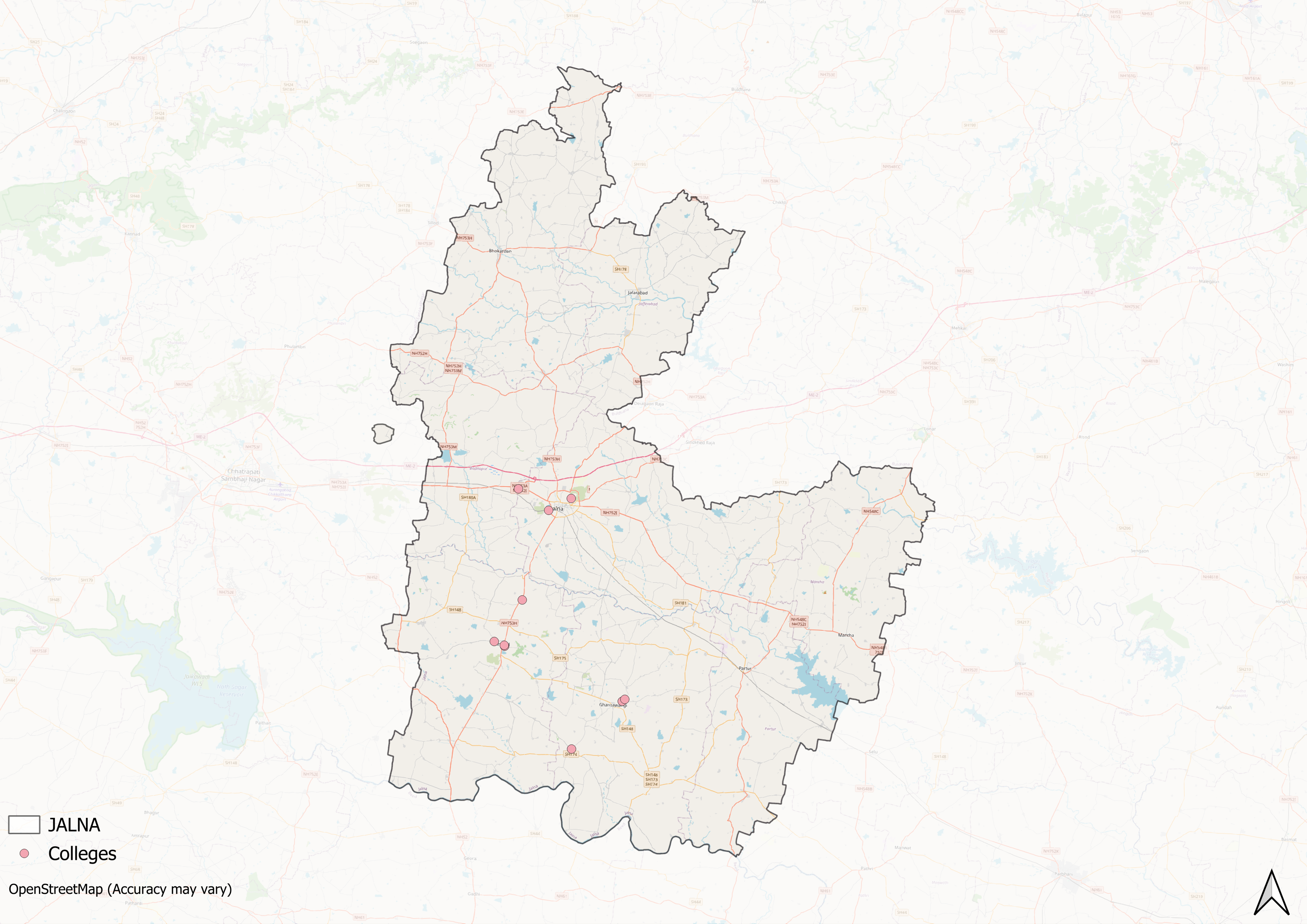
In addition to these institutions, a number of centres for higher education operate throughout the district, which offer programmes across various disciplines. While the landscape of higher education has broadened significantly since independence, disparities in access, particularly along geographic lines, remain evident.
Prominent Figures & Organizations
Jalna Education Society
The Jalna Education Society (JES) was established in 1975 to expand access to higher education in Jalna and the wider Marathwada region. The society was funded through public contributions collected during a visit by Prime Minister Jawaharlal Nehru, and it received additional support from local philanthropists.

JES oversees several institutions of higher learning, including R.G. Bagdia Arts College, S.B. Lakhotia Commerce College, and Rt. Bezonji Science College. These colleges are affiliated with universities in Maharashtra and offer undergraduate and postgraduate programmes across arts, commerce, and science disciplines.
NGOs and Community-Based Education Efforts
Education has been a key driver of social reform, particularly in addressing inequality and expanding access to learning. While formal institutions provide structured education, many communities continue to face barriers due to poverty, social stigma, or lack of resources. To address these challenges, various organisations in Jalna have focused on community-based education initiatives, with each working to tackle specific social challenges present in the district.
Jagdish Kude and Educational Reform in Shriram Tanda
Jagdish Kude, a teacher and social worker based in Shriram Tanda village, has been notable for his grassroots efforts to improve educational access in rural Jalna. Beginning his work in 2004 at the local Zilla Parishad (Z.P.) school, then operating in a tin shed with around 20 students, Kude focused on reducing dropout rates among children of migrant sugarcane labourers, particularly from the Banjara community.
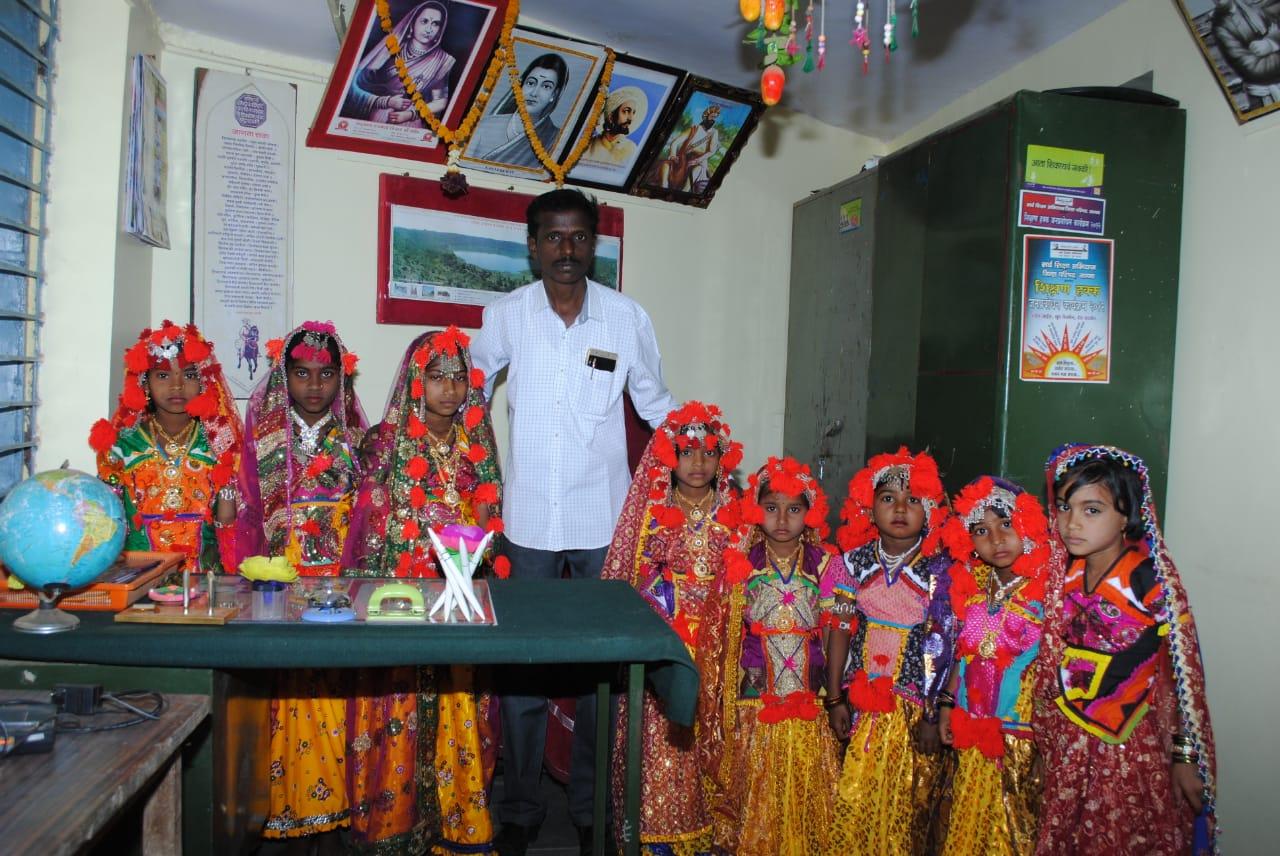
To address high levels of seasonal migration, Kude engaged with parents through community meetings and encouraged them to keep their children enrolled in school by leaving them in the care of relatives during migration periods. His outreach efforts extended to learning the Banjara Boli, which helped foster stronger teacher-student relationships and improved participation.
Under his leadership, the school saw an increase in student enrollment to over 125 and a rise in the average age of marriage for girls, reflecting a reduction in early marriages. Kude’s approach integrated educational activities with community development initiatives, such as student-run weekly bazaars, a student banking system, digital classrooms, an open library, and environmental programs like "One Child, One Tree." These initiatives aimed to make education more engaging while imparting life skills.
Kude also addressed broader social issues in the village, including alcohol abuse and support for orphans, positioning education as part of a wider strategy for rural upliftment. His efforts earned him multiple awards, including the Maharashtra State Teacher Prize (2016) and the Sharad Pawar Inspire Fellowship (2022).
His work has been particularly influential in Mantha taluka, where he successfully curbed the migration of school-aged children from Banjara communities by promoting education through direct engagement with local Tandas (settlements).
Graphs
Enrollment and Dropout Rate
Schools
Teachers
Sources
College of Agriculture, Kharpudi. “About.” https://coakharpudi.in/about.htmlhttps://coakharpudi.in/about.html
Indica Today. “The Spiritual Journey of Warrior Saint from Maharashtra: Samarth Ramdas.”https://www.indica.today/long-reads/the-spir…
Institute of Chemical Technology, Mumbai. “Marathwada Centre.”https://marj.ictmumbai.edu.in/DisplayPage.aspx?page=cc&ItemID=ckhttps://marj.ictmumbai.edu.in/DisplayPage.as…
MSS College of Engineering & Technology, Jalna. “Home.”https://www.msscetjalna.org/https://www.msscetjalna.org/
Niraj Pandit. 2023. “It Takes a Village: How Residents of a Jalna Taluka Have United to Stop a Teacher’s Transfer.” Hindustan Times, June 6, 2023.https://www.hindustantimes.com/cities/mumbai…
The Daily Guardian. “The Revolutionary Teachings of Samarth Ramdas.”https://thedailyguardian.com/the-revolutionary-teachings-of-samarth-ramdas/https://thedailyguardian.com/the-revolutiona…
Last updated on 28 July 2025. Help us improve the information on this page by clicking on suggest edits or writing to us.